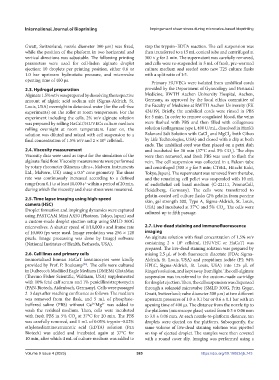Page 393 - IJB-9-4
P. 393
International Journal of Bioprinting Impingement shear stress during microvalve-based bioprinting
Gwatt, Switzerland; nozzle diameter 300 µm) was fixed, stop the trypsin–EDTA reaction. The cell suspension was
while the position of the platform in two horizontal and then transferred to a 15 mL conical tube and centrifuged at
vertical directions was adjustable. The following printing 300 × g for 3 min. The supernatant was carefully removed,
parameters were used for cell-laden alginate droplet and cells were re-suspended in 5 mL of fresh, pre-warmed
ejection: 10 droplets per printing position, either 0.6 or culture medium and seeded onto new T25 culture flasks
1.0 bar upstream hydrostatic pressure, and microvalve with a split ratio of 1:5.
opening time of 400 µs. Primary HUVECs were isolated from umbilical cords
2.3. Hydrogel preparation provided by the Department of Gynecology and Perinatal
Alginate 1.5% wt/v was prepared by dissolving the respective Medicine, RWTH Aachen University Hospital, Aachen,
amount of alginic acid sodium salt (Sigma-Aldrich, St. Germany, as approved by the local ethics committee of
Louis, USA) overnight in deionized water (for the cell-free the Faculty of Medicine at RWTH Aachen University (EK
experiments) on the roller at room temperature. For the 424/19). Briefly, the umbilical cords were rinsed in PBS
experiment including the cells, 2% w/v alginate solution for 5 min. In order to remove coagulated blood, the veins
was prepared by rolling HaCaT/HUVECs culture medium were flushed with PBS and then filled with collagenase
rolling overnight at room temperature. Later on, the solution (collagenase type I, 400 U/mL, dissolved in Hank’s
solution was diluted and mixed with cell suspension to a Balanced Salt Solution with CaCl and MgCl , both Gibco
2
2
final concentration of 1.5% w/v and 2 × 10 cells/mL. by Life Technologies, USA) and closed with a clip at both
6
ends. The umbilical cord was then placed on a petri dish
2.4. Viscosity measurement and incubated for 30 min (37°C and 5% CO ). The clips
2
Viscosity data were used as input for the simulation of the were then removed, and fresh PBS was used to flush the
alginate fluid flow. Viscosity measurements were performed vein. The cell suspension was collected in a Falcon tube
by rotary rheometer (Kinexus ultra+, Malvern Instruments and centrifuged (300 × g for 5 min; CT6EL, Hitachi Koki,
Ltd., Malvern, UK) using a 0.5° cone geometry. The shear Tokyo, Japan). The supernatant was removed from the tube,
rate was continuously increased according to a defined and the remaining cell pellet was suspended with 10 mL
range from 0.1 to at least 10,000 s within a period of 20 min, of endothelial cell basal medium (C-22111, PromoCell,
-1
during which the viscosity and shear stress were measured. Heidelberg, Germany). The cells were transferred to
gelatin-coated cell culture flasks (2% gelatin from porcine
2.5. Time lapse imaging using high-speed skin, gel strength 300, Type A, Sigma-Aldrich, St. Louis,
camera (HSC) USA) and incubated at 37°C and 5% CO . The cells were
Droplet formation and impinging dynamics were captured cultured up to fifth passage. 2
using PASTCAM Mini AX50 (Photron, Tokyo, Japan) and
a custom-made droplet ejection setup using SMLD 300G
microvalves. A shutter speed of 1/18,000 s and frame rate 2.7. Live-dead staining and immunofluorescence
of 10,000 fps were used. Image resolution was 256 × 128 imaging
pixels. Image processing was done by ImageJ software An alginate solution with final concentration of 1.5% w/v
6
(National Institutes of Health, Bethesda, USA). containing 2 × 10 cells/mL (HUVEC or HaCaT) was
prepared. The live-dead staining solution was prepared by
2.6. Cell lines and primary cells mixing 2.5 μL of both fluorescein diacetate (FDA; Sigma-
Immortalized human HaCaT keratinocytes were kindly Aldrich, St. Louis, USA) and propidium iodide (PI; 94%
provided by Prof. P. Boukamp . The cells were cultured HPLC, Sigma-Aldrich, St. Louis, USA) into 125 μL of
[26]
in Dulbecco’s Modified Eagle Medium (DMEM) GlutaMax Ringer’s solution, and kept away from light. The cell-alginate
(Thermo Fisher Scientific, Waltham, USA) supplemented suspension was transferred to the custom-made cartridge
with 10% fetal calf serum and 1% penicillin/streptomycin for droplet ejection. Then, the cell suspension was dispensed
(PAN-Biotech, Aidenbach, Germany). Cells were passaged through a solenoid microvalve (SMLD 300G, Fritz Gyger,
2–3 days after reaching confluence as follows: The medium Gwatt, Switzerland; valve diameter 300 μm) at two different
was removed from the flask, and 5 mL of phosphate- upstream pressures of 1.0 ± 0.1 bar or 0.6 ± 0.1 bar with an
buffered saline (PBS) without Ca Mg was added to opening time of 400 μs. The distance from the nozzle tip to
2+
2+/
wash the residual medium. Then, cells were incubated the platform (microscope glass) varied from 0.3 ± 0.06 mm
with fresh PBS in 5% CO at 37°C for 20 min. The PBS to 3.0 ± 0.06 mm. At each nozzle-to-platform distance, ten
2
was carefully removed, and 1 mL of 0.05% trypsin–0.02% droplets were ejected on the platform. Subsequently, the
ethylenediaminetetraacetic acid (EDTA) solution (Pan same volume of live-dead staining solution was pipetted
Biotech) was added and incubated again at 37°C for on top of ejected droplet. The samples were then covered
10 min, after which 4 mL of culture medium was added to with a round cover slip. Imaging was performed using a
Volume 9 Issue 4 (2023) 385 https://doi.org/10.18063/ijb.743

